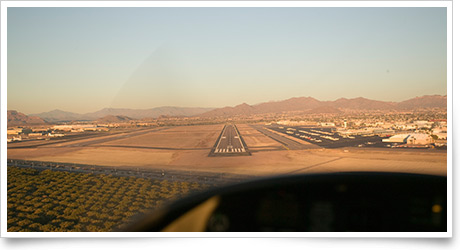| The following stories from the Nov. 02, 2012, edition of AOPA ePilot were provided to AOPA members who expressed an interest in the particular subject areas. Any AOPA member can receive information tailored to their areas of interest by updating their preferences online |
training tipsAvoiding ‘red over red’
Thinking it over later, it wasn’t difficult to identify some clues that could have headed off trouble. One was the wind. It was blowing strongly down the runway, which meant high groundspeed on the downwind leg, but unusually low groundspeed on final. Perhaps the trainee should have adjusted for that by turning base a bit closer in than on a calm day (or by reducing power more gradually, starting with the base turn).
Breaking the rote habit pattern might have helped the student recognize that the trainer was getting too low on final. Do you have a sight picture for judging whether your descent to the runway is proceeding at a correct rate? Many students are taught that if the runway appears to be moving up in the windscreen, you are getting too low. If the runway seems to be slipping away under the nose, you are too high. A stationary runway means a correct glide.
The student pilot noted that the satellite airport being used for practice lacked a visual approach slope indicator (VASI) or other form of vertical guidance. Perhaps he had become too dependent on the home airport’s VASIs.
The approach also illustrated how you can get into trouble by allowing the aircraft to be flown on the “back side of the power curve”—a high-drag condition that can result from the pilot’s adding back-pressure—instead of power—to control the descent. (That situation was starting to develop at the end of the approach just flown.)
The student recalled a session of dual instruction in slow flight: He and his flight instructor had jotted down the airspeeds flown and the associated power settings. Later they created a graph of the power curve for the trainer, which identified the airspeed below which induced drag began to exert its most pronounced effects.
The student also realized that a timely go-around was the remedy once it was obvious that the approach was turning into one of those “red over red” affairs so easy to recognize using the VASI back at the home airport. training productsNFlightCam strut/bar mountMore pilots are videotaping their flights to preserve memories as well as learn from the footage. If you use an NFlightCam for that purpose, this mount from Sporty’s is designed to attach the camera to round surfaces up to 3 inches in diameter. Its double-socket arm and ball design allows you to adjust the camera position in a variety of angles. The mount sells for $49.99 and will ship on Nov. 15. Order online or call 800/776-7897.
Note: Products listed have not been evaluated by ePilot editors unless otherwise noted. AOPA assumes no responsibility for products or services listed or for claims or actions by manufacturers or vendors. final examQuestion: I am just about ready to take the practical test for my commercial pilot certificate, and my medical certificate is about to expire. Since I do not intend to do any commercial flying right away, I was just going to get a third class medical certificate. Some of my fellow pilots have been saying that I need a second class medical certificate in order to take the commercial pilot practical test, while others have said that a third class medical is just fine. I am a little confused. Which class medical do I need?
Answer: Perhaps there is some confusion between what class medical is required in order for you to fly for hire and what class medical is required for you to take the practical test. FAR 61.39 (a)(4) only requires an individual to hold a third class medical, if one is required, in order to be eligible to take a practical test. You will, of course, need to obtain a second class medical when you are ready to start flying for hire.
Got a question for our technical services staff? Email [email protected] or call the Pilot Information Center, 800/872-2672. Don’t forget the online archive of “Final Exam” questions and answers, searchable by keyword or topic. |
 The trainer struggled to the runway threshold, barely making the pavement with high power and stall horn blaring. The student pilot was perplexed by the
The trainer struggled to the runway threshold, barely making the pavement with high power and stall horn blaring. The student pilot was perplexed by the 

